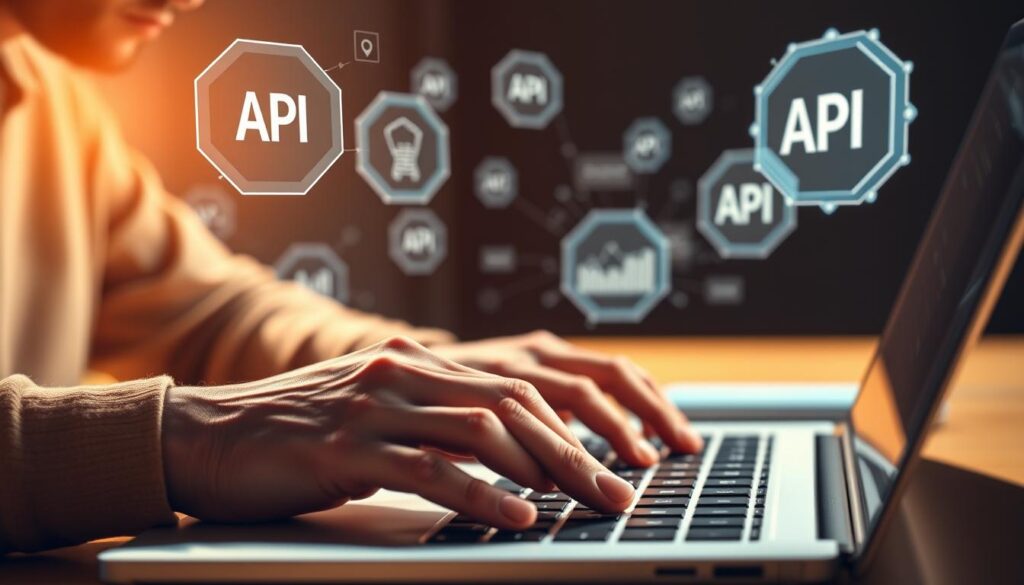Ever wondered why some businesses excel in the AI era while others lag behind? The answer might be their use of APIs for AI. As companies aim to boost AI, APIs are key for smooth integration. They help improve operations and connect different software systems.
In Southeast Asia, innovation is booming. Using APIs helps companies adopt AI and make smart, data-based choices. With more businesses adopting an API-first approach, it’s clear APIs are crucial for digital transformation.
Key Takeaways
- APIs are essential for speeding up AI integration in businesses.
- They enable better communication between different software systems.
- APIs contribute to operational efficiencies and data-driven decision-making.
- Southeast Asian companies are increasingly adopting API-first strategies.
- Innovative solutions powered by APIs enhance AI capabilities.
Understanding APIs and AI Integration
APIs, or Application Programming Interfaces, are key in modern software development. They let different apps talk to each other smoothly. In AI, APIs are crucial for adding AI features to various business systems. They make it easier for businesses to use AI without the usual software integration hassle.
Definition of APIs and Their Importance
APIs are standardized protocols that help apps share data easily. They make complex interactions simple, speeding up development. In today’s digital world, APIs are vital for linking systems and using technology together.
Overview of AI Integration in Business
AI in business is a big deal, making services better and operations more efficient. Companies use APIs to add AI to their systems. This opens up new ways to innovate and meet market needs. Using APIs for AI helps businesses work better and stay ahead in their fields.
How APIs Facilitate AI Deployment & Integration
APIs are key in making AI easier to use and integrate. They connect different software systems, making data sharing smooth. This boosts work efficiency. Companies can use this to add AI features that make work better and more creative.
Seamless Communication Between Software Systems
APIs help different software systems talk to each other easily. This lets companies add new features without a lot of work. It makes AI tools fit right into what they already use.
Companies see faster setup times and better system work. This makes work more efficient.
Real-World Examples of API Use in AI
Companies like Grab show how APIs help with AI. Grab uses APIs to make its delivery service better. It plans the best routes and improves service.
This shows how APIs can help AI in many areas. It helps companies stay ahead in fast-changing markets.

The Transformative Impact of AI-Powered APIs
AI-powered APIs are leading the way in tech innovation. They bring a range of AI tools that boost efficiency and accuracy in many fields. These APIs add advanced features like machine learning and predictive analytics to existing systems.
This not only makes operations better but also helps in making smarter decisions. It also leads to better customer experiences.
AI Capabilities Enabled Through APIs
By using APIs, companies can use data in new ways. They can turn simple tasks into automated ones, saving time and resources. For example, AI chatbots can handle customer questions on their own.
This means faster answers and happier customers. It also makes businesses more flexible and able to change quickly.
Applications of AI in Different Industries
AI is making a big impact in many industries. In healthcare, AI helps analyze patient data fast and accurately. This leads to better care and quicker diagnoses.
In retail, AI helps make shopping more personal. It suggests products based on what customers like. AI’s ability to adapt to different fields shows its key role in innovation.
| Industry | AI Capabilities | Key Benefits |
|---|---|---|
| Healthcare | Data analysis, diagnostics | Improved patient outcomes, efficiency |
| Retail | Personalization, customer insights | Enhanced customer engagement, sales growth |
| Finance | Fraud detection, risk assessment | Reduced losses, improved security |
| Manufacturing | Predictive maintenance, automation | Lower costs, increased productivity |
Benefits of Using APIs for AI Integration
Understanding APIs for AI integration is key in today’s fast-changing business world. These tools boost data analysis and help make better decisions. They connect different data sources, giving businesses a wealth of information easily.
This makes it easier to find useful insights. It helps businesses stay ahead of the competition.
Enhanced Data Analysis and Decision Making
APIs greatly improve data analysis. They give quick access to many data sets. This means companies can analyze data faster and more accurately.
This leads to better decision-making. Businesses can quickly adjust to changes. APIs help find insights that would take a long time to get, improving strategies.
Streamlined Processes and Automation of Tasks
APIs are key in making processes more efficient. They automate routine tasks, saving time and resources. For example, banking uses APIs to automate transactions, cutting costs and boosting productivity.
By automating tasks, businesses can use their resources better. This makes operations smoother overall.

| Benefit | Description |
|---|---|
| Enhanced Data Analysis | Faster access to data enables more timely and relevant insights. |
| Improved Decision Making | Data-driven decisions lead to better strategic planning and execution. |
| Automated Processes | Routine tasks are automated, allowing teams to focus on high-value activities. |
| Cost Reduction | Efficiencies gained through automation result in reduced operational costs. |
| Increased Productivity | Employees can dedicate time to strategic tasks rather than repetitive actions. |
The Shift Toward an API-First Strategy
Companies are moving from a code-first to an API-first strategy. This change is key for better efficiency and innovation. By focusing on APIs first, businesses can work more smoothly and quickly adapt to market changes.
Comparing API-First vs. Code-First Approaches
Both strategies have their strengths, but they differ:
| Aspect | API-First Approach | Code-First Approach |
|---|---|---|
| Integration Flexibility | High | Medium |
| Speed of Deployment | Faster | Slower |
| Team Collaboration | Enhanced | Limited |
| Future Scalability | Greater | Restricted |
Why Companies Must Adopt an API-First Mindset
The API-first strategy boosts teamwork, leading to better workflows and resource use. It helps companies align their software with business goals. Amazon and Netflix show how this approach leads to fast innovation and great customer experiences.
Challenges in AI Integration Without APIs
Adding AI to business operations is hard. Without APIs, companies face big hurdles. These problems slow down progress and hold up important results.
Common Bottlenecks in Traditional Integration
Using old methods without APIs creates problems. It leads to teams working in separate silos. This makes communication hard and slows down work.
Teams often spend too much time on simple tasks. They could be working on new ideas instead.
The Cost of Delayed Integration
Delays in AI integration cost a lot. Missing out on market chances is a big issue. Slow updates let others take the lead.
In the Philippines, using AI to stay ahead is key. But, delays can hurt finances and lose customer trust.

Enhancing Collaboration Through API-Driven Development
In today’s fast world, teamwork is key to innovation. API-driven development helps teams work better together. It cuts down on delays in projects, making work faster and better.
Decoupling Dependencies to Foster Innovation
APIs help teams work on their parts without holding others back. This is great for fast-changing fields like tech and healthcare. It lets companies quickly update their products to meet user needs and market changes.
Enabling Cross-Functional Teamwork
APIs make teamwork across different areas better. They offer a clear way for everyone to work together smoothly. For example, tools that use APIs help teams share info and work together better.
Using these tools boosts creativity and quickness in responding to the market. This leads to big improvements in what companies offer.
Future Trends in API and AI Integration
The world of API and AI integration is changing fast. New technologies are opening up exciting possibilities. Companies are looking for ways to be more efficient and stay ahead. Understanding these trends is key.
Innovations like serverless computing and advanced management platforms are changing how we develop. These changes will make the process more efficient and scalable.
Emerging Technologies in API Development
API development has seen big changes lately. Serverless architectures let developers focus on coding, not infrastructure. This makes development faster and more scalable.
Also, new API management tools are improving security and monitoring. This makes APIs stronger and easier to use with AI.
Predictions for the Next Decade in AI and APIs
In the next decade, AI will make user experiences even more personal. Businesses will need to use advanced AI functions more. Companies that adopt these trends will have a big advantage.
The next decade will see huge progress in API and AI integration. This will change how industries work and interact with customers.

Real-World Success Stories of API and AI Integration
Looking at real-world success stories shows how APIs and AI change things. They make a big difference in healthcare and retail. Companies using these technologies see big improvements in how they work and how happy their customers are.
Case Study: AI in the Healthcare Sector
In healthcare, AI APIs help make patient care better. For example, HealthNow uses AI to look at patient data. This helps them make more accurate diagnoses and treatment plans.
This change makes patient care much better. It shows how AI helps both healthcare providers and patients.
Case Study: AI in Retail and Customer Experiences
Retail big names like Sephora use AI APIs to make shopping better for customers. They use data to give customers just what they want. This makes customers more engaged and loyal.
Using AI in retail also makes brands stronger. These stories show how smart technology meets customer needs.
| Sector | Company | API Use | Outcome |
|---|---|---|---|
| Healthcare | HealthNow | AI for patient data analysis | Improved diagnostic accuracy |
| Retail | Sephora | AI for personalized shopping | Higher engagement and loyalty |
Key Considerations for Businesses Transitioning to API Integration
Switching to API integration needs careful planning. Businesses must plan their API strategy and set goals. They should also make sure all teams follow the same practices. This helps everyone work together better, making workflows more efficient.
Defining Your API Strategy and Goals
Creating a strong API strategy is key when moving to API integration. Companies should look at their needs and the market before setting goals. This often involves:
- Assessing current capabilities to find areas for growth.
- Setting clear objectives that match business goals.
- Choosing key APIs that will have the biggest impact.
Standardizing API Practices Across Teams
Having the same API practices in all teams is vital for success. By using the same standards, companies can:
- Improve teamwork between departments.
- Lessen mistakes and misunderstandings.
- Make development faster and projects quicker.
As companies go through this change, it’s important to keep training and checking up. By getting teams ready, companies can make the most of their API plans.
| Key Steps | Description |
|---|---|
| Evaluate Needs | Analyze what you need and the market. |
| Set Goals | Make goals you can measure to see how you’re doing. |
| Implement Standards | Make sure everyone uses the same methods and practices for API development. |
| Provide Training | Teach teams what they need to know for successful integration. |
| Conduct Audits | Check how well APIs are working and if everyone is following them. |
Measuring the ROI of API-Driven AI Integration
It’s key for businesses to know how to measure ROI of APIs in AI integration. They need to set clear API integration KPIs to show if their efforts are paying off. By focusing on the right metrics, they can see the real benefits of combining APIs with AI systems.
Key Performance Indicators (KPIs) for Success
Businesses should focus on a few important KPIs to check if API-driven AI integration is working. These include:
- Operational Efficiency: Look at how workflows and resource use have improved.
- Speed of Integration: See how fast new features and systems are added.
- User Satisfaction: Get feedback from users to check if the solutions are easy to use.
- Revenue Generation: Watch how AI integration affects sales and profits.
By keeping an eye on these KPIs, businesses can make their strategies better and work more effectively.
Long-Term Benefits to Strategic Decision Making
API-driven AI integration also brings long-term benefits. It makes businesses more agile and quick to respond to market changes. This agility leads to more innovation and the ability to make quick changes, improving their competitive edge. Knowing these benefits is crucial for making the case for investing in API technologies.
Conclusion
APIs play a huge role in AI integration, which is key in Southeast Asia’s fast-changing business world. They help systems talk to each other smoothly. This lets companies use AI to improve how they work.
APIs make teamwork better by making processes easier. This helps businesses use AI to its fullest. By focusing on APIs first, companies can keep up with digital changes and find new chances.
The future of APIs looks bright, with new ways to improve AI integration. This will change how businesses work. Companies that use APIs well will stay ahead and do well in the future.

